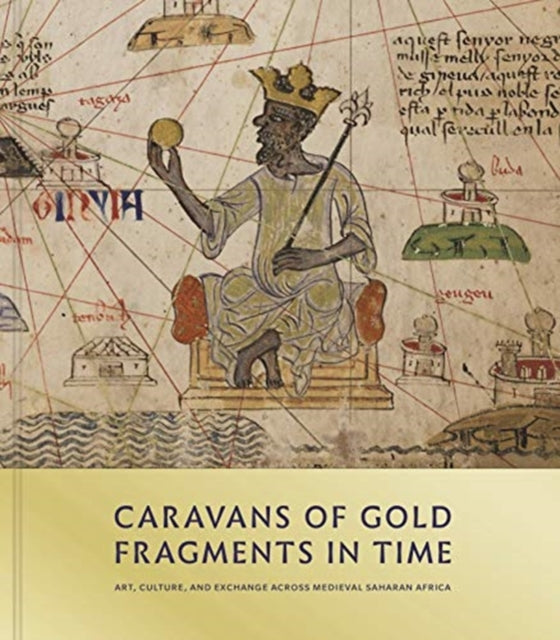Kathleen Bickford Berzock
Caravans of Gold, Fragments in Time: Art, Culture, and Exchange across Medieval Saharan Africa
Caravans of Gold, Fragments in Time: Art, Culture, and Exchange across Medieval Saharan Africa
YOU SAVE £11.83
- Condition: Brand new
- UK Delivery times: Usually arrives within 2 - 3 working days
- UK Shipping: Fee starts at £2.39. Subject to product weight & dimension
Bulk ordering. Want 15 or more copies? Get a personalised quote and bigger discounts. Learn more about bulk orders.
Couldn't load pickup availability
- More about Caravans of Gold, Fragments in Time: Art, Culture, and Exchange across Medieval Saharan Africa
The Sahara Desert was a vital crossroads for trade in the medieval world, with West African gold being prized for its purity and used to mint currencies and adorn luxury objects. Caravans carried goods for trade, including glass vessels, beads, glazed ceramics, copper, books, and foodstuffs. Northward, they brought gold, ivory, animal hides and leatherwork, spices, and captives from West Africa. Caravans of Gold, Fragments in Time is a compelling look at medieval trans-Saharan exchange and its legacy, featuring case studies of key medieval cities, networks of exchange, and medieval glass bead production.
Format: Hardback
Length: 312 pages
Publication date: 26 February 2019
Publisher: Princeton University Press
The Sahara Desert, a vast expanse spanning West Africa, North Africa, the Middle East, and Europe, played a pivotal role as a bustling crossroads of exchange during the medieval period. The catalyst for this exchange was the prized West African gold, renowned for its purity and sought after for various purposes, including currency minting, the creation of luxurious objects such as jewelry, textiles, and religious artifacts, and adorning them. To facilitate this trade, hardy caravans embarked on arduous journeys, traversing the scorching Sahara by camel. These caravans carried a diverse array of goods, including glass vessels and beads, glazed ceramics, copper, books, and various foodstuffs, including the precious salt obtained in the heart of the desert.
In their northward direction, the caravans brought not only gold but also valuable commodities such as ivory, animal hides and leatherwork, spices, and captives from West Africa, who were forcibly enslaved. These trans-Saharan exchanges not only facilitated the flow of goods but also fostered cultural and artistic interactions. Key medieval cities, such as Timbuktu, Cairo, and Fez, emerged as hubs of trade, where merchants from different regions converged to exchange their wares. Networks of exchange, established through caravan routes and trade routes, played a crucial role in the circulation of gold, copper, and ivory, as well as their associated art forms.
Medieval glass bead production in West Africa's forest regions also flourished, with artisans creating intricate and beautiful beads using local materials. The book "Caravans of Gold, Fragments in Time" delves into the latest archaeological discoveries and art historical research to provide a comprehensive understanding of medieval trans-Saharan exchange and its enduring legacy. Contributors from diverse disciplines present case studies that shed light on various aspects of this exchange, including descriptions of key medieval cities, the networks that facilitated the circulation of gold and other commodities, and the production of medieval glass beads in West Africa.
Furthermore, the book explores the rich material culture of Morocco's Gnawa, descendants of West African slaves, and the movements of people across the Sahara today. The volume is adorned with a wealth of color images that vividly depict the historical and cultural landscape of the Sahara during the medieval period. These "fragments in time" serve as irrefutable evidence of Africa's significant role in medieval history and underscore the enduring connections between different regions and peoples.
In conclusion, the Sahara Desert was a vital conduit for trade and cultural exchange during the medieval period, with West African gold playing a central role. Caravans of goods, including gold, ivory, spices, and captives, traversed the desert, fostering economic, social, and artistic interactions. The legacy of this exchange continues to be felt today, as evidenced by the ongoing exploration of the Sahara and the study of its rich historical and cultural heritage.
Weight: 2012g
Dimension: 289 x 257 x 25 (mm)
ISBN-13: 9780691182681
This item can be found in:
UK and International shipping information
UK and International shipping information
UK Delivery and returns information:
- Delivery within 2 - 3 days when ordering in the UK.
- Shipping fee for UK customers from £2.39. Fully tracked shipping service available.
- Returns policy: Return within 30 days of receipt for full refund.
International deliveries:
Shulph Ink now ships to Australia, Belgium, Canada, France, Germany, Ireland, Italy, India, Luxembourg Saudi Arabia, Singapore, Spain, Netherlands, New Zealand, United Arab Emirates, United States of America.
- Delivery times: within 5 - 10 days for international orders.
- Shipping fee: charges vary for overseas orders. Only tracked services are available for most international orders. Some countries have untracked shipping options.
- Customs charges: If ordering to addresses outside the United Kingdom, you may or may not incur additional customs and duties fees during local delivery.


